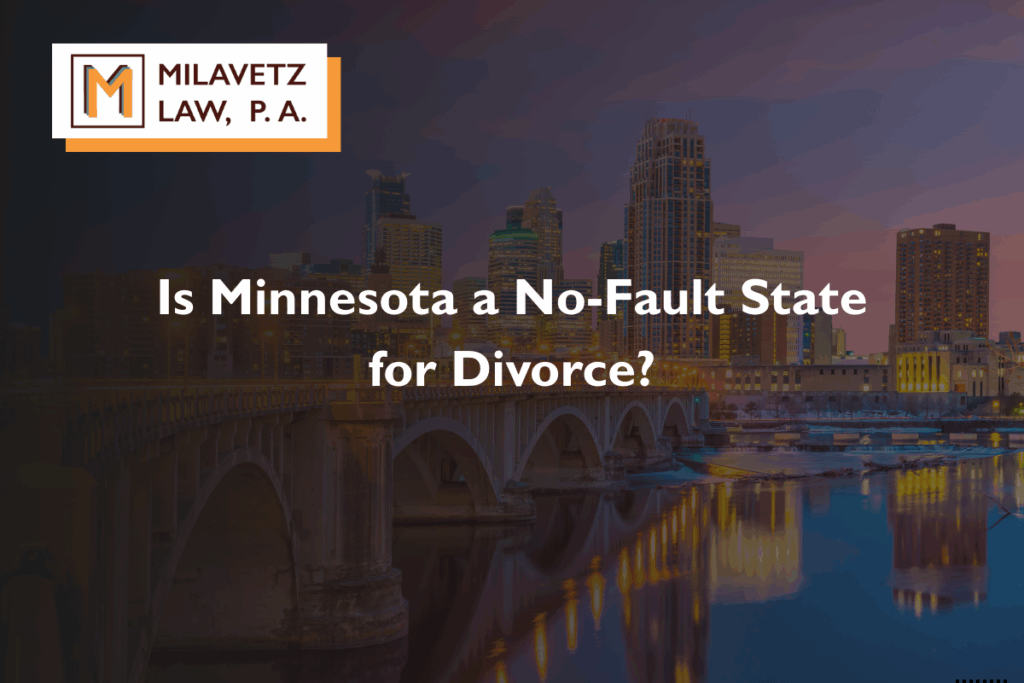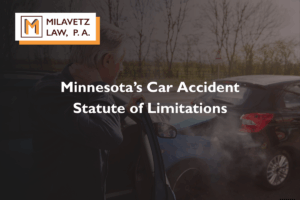
Divorce is fairly mainstream in the United States today. Gone are the days when spouses would remain married while enduring loveless marriages for fear of tarnishing their reputations. Today, many Americans marry, divorce, and later remarry the true love of their life.
In Minnesota, a no-fault divorce eases many traditional challenges of divorce by allowing divorce even when neither you nor your spouse has committed erroneous actions, such as abuse or adultery. By removing the necessity of proving fault, the law makes divorces potentially less contentious and stressful.
However, there are certain instances when proving fault can help your case. You may want to prove fault to help you receive a fair division of marital assets or to gain custody of your children. The Minnesota divorce lawyers at Milavetz Injury Law, P.A. can advise you of your legal options.
Need Legal Help with a Divorce?

What Is No-Fault Divorce in Minnesota?
Minnesota is a no-fault divorce state. A no-fault divorce means you can request a divorce if you believe your marriage is irreparably broken and do not have to prove your spouse did something wrong. If the court agrees that the union is beyond repair, they will issue you a dissolution of marriage. A court-issued dissolution of marriage completely terminates your marital status.
How Long Do You Have to Be Separated Before Getting a Divorce?
Minnesota does not require a trial separation period before granting a divorce. Additionally, if you request a legal separation and your spouse does not contest your plea or request a dissolution, the court will grant the decree. Defenses that were previously available to contest the divorce have been abolished. These defenses included the following:
- Condonation
- Connivance
- Collusion
- Insanity
- Lapse of time
- Recrimination
A no-fault divorce means you do not have to prove that the marriage’s failure was your spouse’s fault to terminate your marriage. A strong desire to end the relationship is sufficient grounds for dissolution.
Pros and Cons of a No-Fault Divorce
Every state chooses how to frame its divorce laws, and Minnesota is no different. These laws offer a range of benefits and challenges for those considering divorce.
Benefits of a No-Fault Divorce in Minnesota
Some of the benefits associated with Minnesota’s no-fault divorce include:
- Simplified process: Minnesota does not require a trial separation before granting your divorce.
- Privacy: There is no requirement to prove fault and drag your spouse’s name through the mud.
- Reduced legal fees: Because you do not need to prove fault, the entire process is quicker and easier, reducing your legal costs.
- Court efficiency: With the issue of fault removed, courts can grant divorces quicker and move on to hearing more complex legal cases.
- Speed: The court can generally process no-fault cases faster than cases involving fault.
- State trust: The state trusts you to determine the needs of your marital union.
- Lowered emotional burden: Allowing spouses to walk away without proving fault significantly reduces the emotional burden on couples. It may even increase your chances of an amicable divorce.
Challenges of Minnesota's No-Fault Divorce Law
No-fault divorce laws also bring unique challenges, such as:
- Lack of accountability: If you believe your spouse has truly wronged you, a no-fault divorce may not satisfy your desire to expose their behavior.
- Marriage instability: Similar to the accountability argument, some groups argue that no-fault divorce leads to greater marriage instability in the United States. Opposing arguments to these views promote empowerment and the ability to leave a spouse whose mistreatment falls within legal boundaries.
- Perceived ease: Some opponents of no-fault divorce laws argue that these laws make it too easy for couples to divorce. They believe some couples give up on their marriage without attempting to resolve the issues.
- Potential for unresolved issues: Sometimes, proving fault may benefit your case. This could be relevant when the court divvies up the couple’s debts and assets or determines child custody.
When You Must Prove Fault
There are specific instances when proving fault can play to your advantage, such as when the court divides marital property or determines child custody.
Child Custody and Fault
If you want custody of your children, proving fault can help. For example, if your spouse was abusive or engaged in activities that would lead the court to believe they were an unfit parent, providing proof of these tendencies could help you win custody of your children.
Fault and the Court's Division of Marital Assets
Under Minnesota law, the baseline for dividing marital assets is an even split. However, proof of certain activities could lead the court to deviate from this practice and award one spouse a larger percentage of the assets.
The court may distribute marital assets differently if your spouse engages in the following activities without your consent:
- Transfers marital assets
- Encumbers marital assets
- Conceals marital assets
- Disposes of marital assets
If the court finds that your spouse claimed additional marital assets using deceptive or unfair methods, it may award you a greater percentage of the remaining assets as an offset. However, as the accusing spouse, you bear the burden of proof. So you will need to provide the court with proof. Selling or using assets for the necessities of life or in the usual course of business is one exception the court accepts.
How to Get Divorced in Minnesota
To qualify for a divorce in Minnesota, at least one spouse must currently live in Minnesota for at least 180 days. An exception to residency exists for armed forces personnel.
If you qualify for a Minnesota divorce, you must file the appropriate court forms with the district court in the county where you or your spouse live.
Examples of forms you may need to complete and file include:
- Divorce petition: A Summons and a Petition for Dissolution of Marriage are filed with the county clerk’s office, beginning the divorce case
- Response a divorce petition: Used when your spouse initiates the divorce.
- Requests for temporary orders: Used to request a temporary order on support, property, or custody issues. These orders only last until the court finalizes your dissolution.
- Real estate forms: These could include a Summary Real Estate Disposition Judgment or a Quit Claim Deed.
Additionally, there are other forms you may need to file after your divorce, such as paperwork concerning the following:
- Child support or other issues affecting children
- Child custody and issues with parenting time or visitation
- Contempt of court over failures to follow court orders
Many people find the stress of divorce staggering, even before considering the legalities involved. An experienced Minneapolis divorce lawyer can guide you through your divorce, manage your legal documents, and prove any necessary fault.
Millavetz Injury Law, P.A., Can Help
If you are in the midst of a divorce or considering a divorce in Minnesota, reaching out to a knowledgeable, trusted divorce attorney can provide unparalleled guidance and legal advice.
The skilled lawyers at Millavetz Injury Law, P.A., can help you with your divorce and ensure you receive a fair division of marital property and parenting time or custody. During your free consultation, Millavetz Injury Law, P.A., can answer your questions about Minnesota divorce laws, spousal abandonment, and grounds for divorce in Minnesota.
Contact us to arrange your free, confidential consultation with our Minnesota divorce lawyer.

















